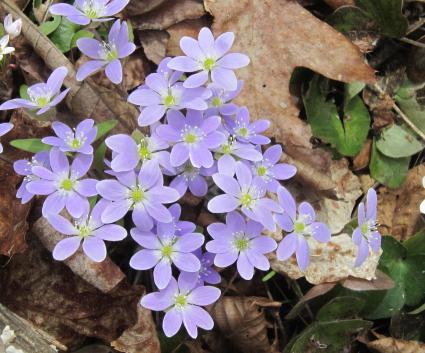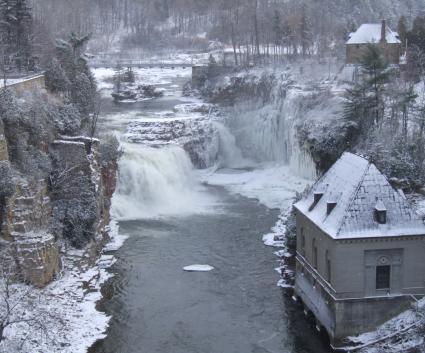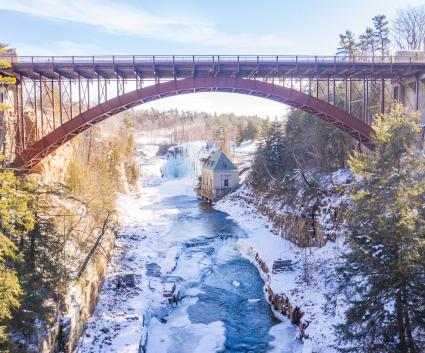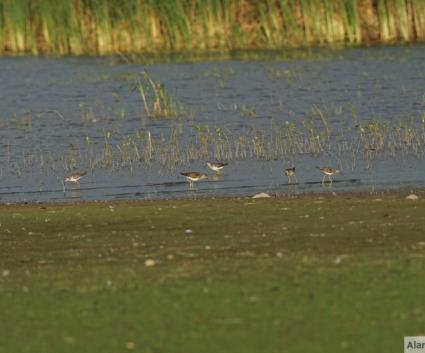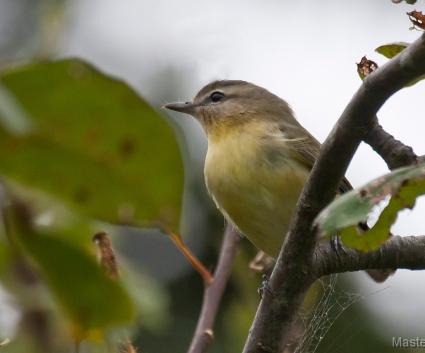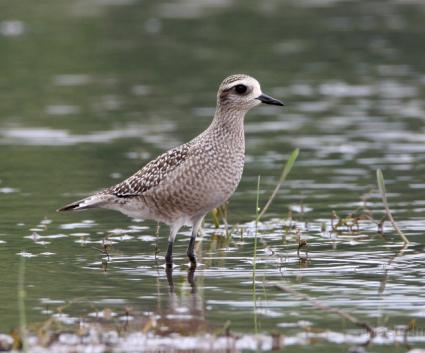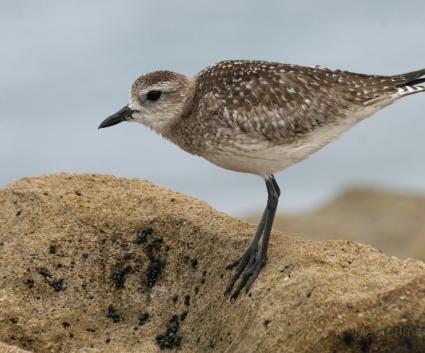Tracking Wildlife on Snowshoes
Sure, a lot of people love snowshoeing on a marked trail to the top of a mountain or along a loop through a beautiful Adirondack forest. That’s admirable.
In contrast, my recent snowshoe excursion involved bushwhacking through deep snow over downed trees and frozen swamps; all to solve a mystery.
It all started when I saw that Champlain Area Trails (CATS) was hosting a winter wildlife tracking snowshoe expedition at Poke-O-Moonshine with naturalists Elizabeth Lee and David Thomas-Train. I’ve gone on hikes with Elizabeth, a licensed Adirondack guide, in the past, and I always enjoy David’s company, so I penned this one into my calendar right away.
We met at the beginning of the new, 2.3-mile Observers Trail that follows the route of the old Fire Observer’s access road. Until this day, I was only familiar with the steeper 1.2 mile Ranger Trail that leads to the fully restored 1918 fire tower at the top. The new, longer and more gradual Observers Trail passes through varied terrain and forest, including several beaver ponds.
But we weren’t necessarily going to follow the trail, I later found.
POWDER
It’s a whole different experience when one brings a naturalist along for a hike. Every step can present a new opportunity to learn about the flora, fauna and the habits and activities of those who live in that particular habitat. And on this day, we’d be looking for evidence and solving the mystery of the behavior of the animals who live and play in the shadow of Poke-O-Moonshine.
Our group, which consisted of David, Elizabeth, myself and one other gentleman named Walt, began our snowshoe jaunt in about 8 or more inches of fresh snow on top of a packed base.
This was good and bad for our tracking purposes. Good because we would easily see any recent wildlife activity on a relatively blank canvas in the woods. And bad because the snow was so deep, light and powdery that an animal of any weight would obscure their own tracks when they removed their foot from the snow to take the next step. Elizabeth illustrated this for us by placing her trekking pole straight into the snow and then removing it. When the pole was removed, the light snow sifted back down into the hole she had created and powdery bits also scattered where the pole had entered.
We started our tracking trek. We followed the trail for a while - easily identified since two backcountry skiers had packed it just before we arrived. The first sign of any wildlife was a teeny tiny line in the snow off to the side of the trail. Our naturalists identified that line as being the tracks of either a vole or other small rodent. In the powdery snow it was difficult to know whether the rodent was hopping along on top or tunneling just below. Elizabeth called it a “brave mouse”, as any such rodent on top of the snow would be easy prey for owls or other predators.

TREE OF LIFE
As we walked along, there was a big, dead-looking tree with a trail marker on it. We immediately recognized evidence of pileated woodpecker activity on the tree. The birds would have been looking for insects and larvae in the layers below the bark.
As we looked at the dead tree, David mentioned something then that changed my perspective of the woods altogether. “It’s actually difficult to determine exactly when exactly a tree dies,” he said. He explained that some trees might appear to be dead, but unseen parts of it - perhaps the root system - might still be taking nutrients from the earth. He also said that the forest’s ecosystem benefits from the dead tree hosting fungi, insect larvae, etc. “Trees are actually full of more life after they are dead.”
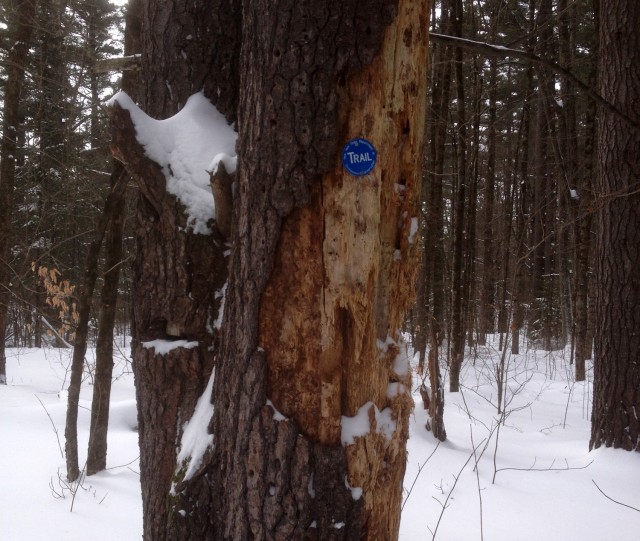
This discussion, of course, reminded me of “The Princess Bride” when the character Wesley was brought back from being merely “mostly dead”. But I digress.
LOOK UP
We left the perhaps-dead tree and traveled farther down the trail, spotting several instances of brave mice tracks in the snow. Before long, though, we spotted the tracks of something significantly larger.
No, it wasn’t a bear or anything. Something in the weasel family, Elizabeth said. From the series of tracks, she said that it was a “bounder”, as opposed to a hopper, walker or waddler. “I think it’s a fisher,” she said, and David agreed, mentioning that they are prevalent in this area.
The tracks showed something with four feet that had “bounded” through the snow. From the amount of snow it had packed down and the size of the holes, it was an animal that is the size of a fisher. A fisher is a medium-sized mammal in the weasel family that can be 29-47 inches long and weigh 4 to 13 pounds, depending on whether it’s a male or female.
Here was the mystery - was it truly a fisher? We decided to follow the tracks to see if we could view a clear paw print - the powdery snow was obscuring a good one where we first encountered the tracks.
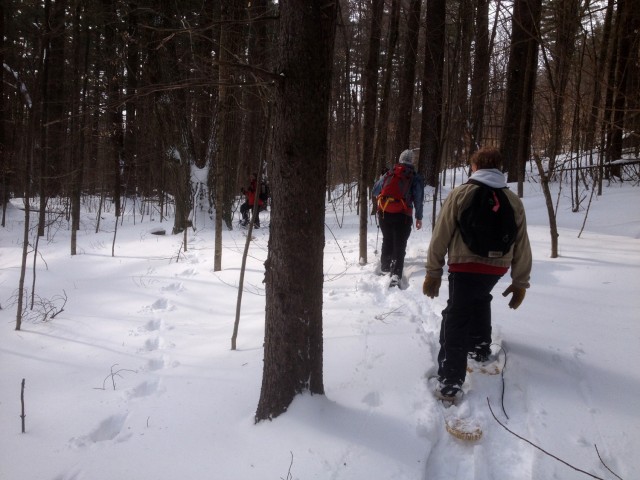
I’ve heard about fishers in the context of them attacking small domestic pets. I learned that though they are capable of taking a cat, they would more likely find plenty of wild prey here in the woods. David mentioned that fishers are the only predators of porcupines, as they can easily and quickly kill them via their underbelly, avoiding the quills. In addition, David would regret mentioning that they will climb trees and jump down on their prey. I’m surprised I didn’t fall down more during the rest of our trek as I kept looking to the treetops in defense.
We decided to follow the tracks through the woods to investigate. It would have been fitting, to me, if we were wearing Sherlock Holmes hats or maybe carrying a magnifying glass as we continued on through the deep powder, staying just to the side of the tracks we were following, over trees and frozen swamps along the way.
Elizabeth pointed out spots where the fisher had rubbed on a tree or root. They have glands all over their bodies, and they mark these spots to notify the opposite sex that they are available, or sometimes to mark their territory.
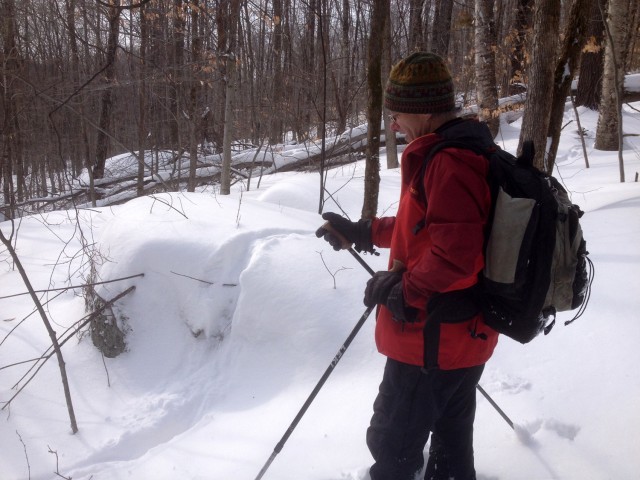
We stopped at one point where the fisher had obviously slid down a rock in an otter-like fashion. Easy to picture, since it’s in the weasel family, too. Finally, we found at the base of a tree not only some scat, or droppings where the fisher had stopped to mark but some great tracks. I took a picture of them next to my hand. Then I looked quickly up into the high branches of the tree above me. (All clear.)
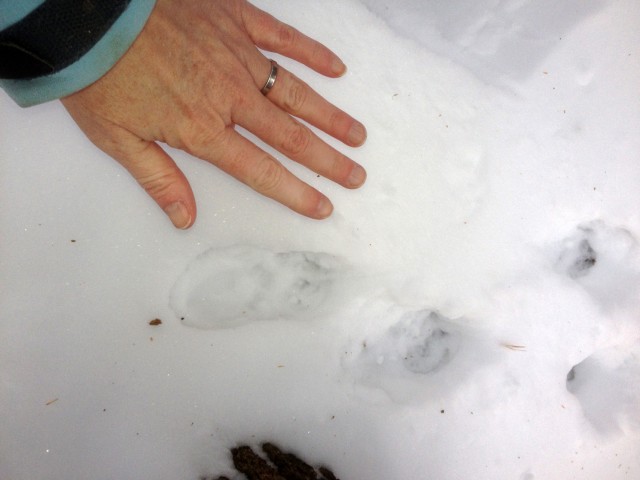
BIG FOOT
At around this point, Walt, otherwise fairly quiet, asked if our naturalists had ever visited a website that keeps track of Bigfoot sightings. Neither had. He highly recommended it, reciting a URL that I don’t recall, and told us that there had been sightings in our area - not far from where we were that day, in fact. Apparently, I didn’t have much to worry about, as the danger was swiftly dismissed by our naturalists, but I think that Walt hoped we’d find bigger tracks today.
We decided to leave the fisher trail and bushwhack uphill to intersect again with the Observer’s Trail. On the way, David spied claw marks where a black bear had climbed a tree get to the top branches. Bears, of course, do have Big Feet.
Before we reached the actual trail, we stopped to see a great example of a “grouse hole”. The grouse entered the deep snow for shelter, and created the hole and accompanying wing marks in the snow when it emerged. Since the snow was so new, this must have been a recent rest stop for the bird. The hole itself had evidence of some feathers and “sawdust” looking stuff; positive clues.
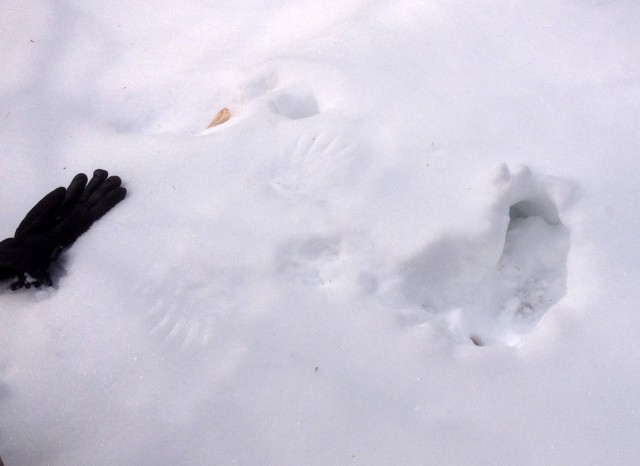
Moving on, we stopped for snacks, then decided to try our luck in finding tracks further down the trail. We didn’t see much other than evidence of some more brave mice and turned around to head back to our cars. Before we got too far, Elizabeth spotted a small tree with marks on it - its bark was scraped by deer's antlers. It's called a "deer rub", which typically appear in the late summer or early fall when male deer rub the velvet off their newly acquired antler growth or during rut season.
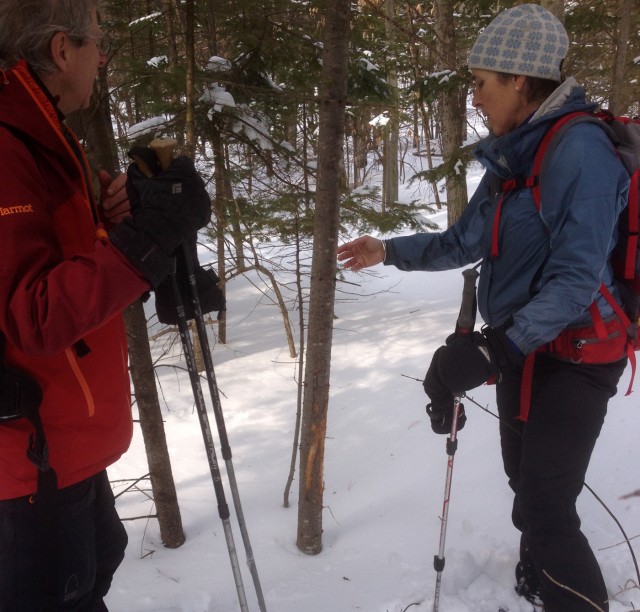
We were tromping along more easily on the packed trail, and downhill, but despite our speed, we did spy one more track. It was a smaller animal than the fisher, but with similar “bounding” style of movement - after a few minutes of consultation, Elizabeth and David agreed that is was a weasel, but not for sure which way it had been bounding.
We returned to our cars, full of knowledge and exhilarated from the exercise. As we said goodbye, Walt reiterating the website where we could learn more about Bigfoot. Removing my snowshoes, I thought about it, and decided that although I might just jump in my kayak and search for Champ this summer, I’d otherwise stick to keeping an eye out for fishers in the trees and solving mysteries like those of The Brave Mice in the Shadow of Poke-O.
-Kim Rielly is the director of communications for the Regional Office of Sustainable Tourism, and is now afraid of fishers.
About Friends of Poke-O-Moonshine
The Friends of Poke-O-Moonshine is a local organization based in the town of Chesterfield that has worked since 1997 to restore the fire tower and trails on popular Poke-O-Moonshine Mountain and to establish a strong environmental education presence there. The steep 1.2 miles long Ranger Trail requires continual work to mitigate rosin and destruction of plants; they install water bars and stepping stones in those areas and have begun to resort the summit vegetation through a careful monitoring and educational process.
The newer, longer and more gradual 2.3-mile Observers Trail follows the route of the old Fire Observers’ access road to the lean-to and former cabin site below the summit. This passes through more varied terrain and forest than the Ranger Trail, including several beaver ponds. The Friends group hopes someday to construct a connector trail between the lower ends of both trails.
The group is directed by an active steering committee which meets monthly, and their work at Poke-O has been supported by major players NYS DEC and the Adirondack Mountain Club. (They also accept donations to further their work at The Friends of Poke-O-Moonshine, c/o their umbrella supporter, Adirondack Architectural Heritage Organization in Keeseville, NY.)
About CATS
Champlain Area Trails (CATS) offers trails for hiking, skiing, snowshoeing, birding, and picnicking in the Champlain Valley of New York State’s Adirondack Park. They are also a land trust working to save the Valley’s natural features, farmland, clean water and scenic vistas.
Watch for another great CATS event this spring!The Grand Inn to Inn Hike from Westport to Essex on May 3 (details to be announced soon!)



